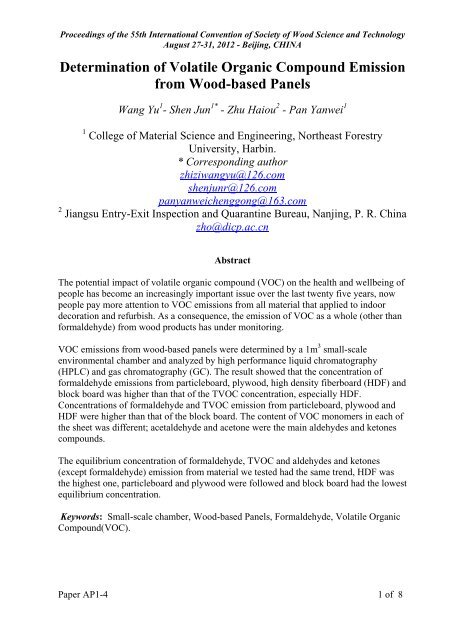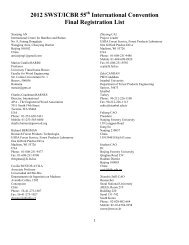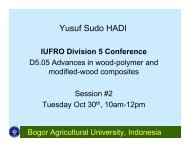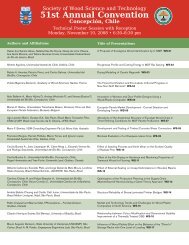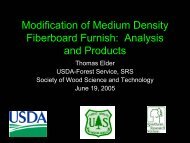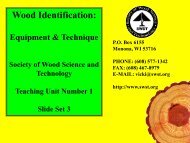AP1-4 - Society of Wood Science and Technology
AP1-4 - Society of Wood Science and Technology
AP1-4 - Society of Wood Science and Technology
You also want an ePaper? Increase the reach of your titles
YUMPU automatically turns print PDFs into web optimized ePapers that Google loves.
Proceedings <strong>of</strong> the 55th International Convention <strong>of</strong> <strong>Society</strong> <strong>of</strong> <strong>Wood</strong> <strong>Science</strong> <strong>and</strong> <strong>Technology</strong>August 27-31, 2012 - Beijing, CHINAThen, analysis on the sample, elution the DNPH sampling tube with acetonitrile, thevolume <strong>of</strong> acetonitrile was 5ml, sample was detected <strong>and</strong> analyzed by HPLC. UsingTenax tube collected VOC, <strong>and</strong> using thermal desorption did the high temperaturethermal desorption ten minutes at 250℃, then detection by GC/M S.According to the peak retention time <strong>of</strong> three kinds <strong>of</strong> particleboard on the GC/MS <strong>and</strong>HPLC, comparing with the st<strong>and</strong>ard sample map, identified VOC components <strong>and</strong>calculated concentration <strong>of</strong> each component.Some st<strong>and</strong>ards about using chamber test VOC regulated that the backgroundconcentration <strong>of</strong> individual target VOC <strong>and</strong> TVOC should not exceed 2μg/m 3 <strong>and</strong>20μg/m 3 respectively [4-6] . Before the test, washing the internal chamber with deionizedwater <strong>and</strong> bilwing dry with fan. We could start test when each parameter <strong>of</strong> chamber wasstable. During the sampling period, the gas orderly through activated carbon device,distill water, to remove the volatile compounds. The effect <strong>of</strong> background concentrationhad been removed in this experiment.Result <strong>and</strong> discussionAccordingly to JIS A 1901:2009 [6] , the range <strong>of</strong>TVOC is between n-hexane <strong>and</strong> n-hexadecane with gas chromatography, including thetwo chemical substances. The calculated TVOC is converted to the sum <strong>of</strong> peak areasusing the toluene response factor, the concentration <strong>of</strong> TVOC was the sum <strong>of</strong> identifiedtarget VOC <strong>and</strong> unidentified VOC.Table 6 the result <strong>of</strong> VOC emission from wood-based panelsspecimen formaldehydeμg/m 3aldehydes <strong>and</strong> ketones(except formaldehyde) μg/m 3TVOCμg/m 3Time (day) 1 28 1 28 1 28Particleboard 140.8 98.3 111.1 22.4 100.8 20.8Plywood 311 117.5 58.6 30.7 19.8 11.8HDF 1541.3 1099.0 73.7 49.5 351.7 65.1Blockboard 41.83 20.33 5.45 2.55 2.69 1.54Table6 was the result <strong>of</strong> VOC emission from wood-based panels. From table2 we couldsee that the initial <strong>and</strong> steady-state concentration <strong>of</strong> all substance that emission from HDFwhich made <strong>of</strong> various kinds mixed polished wood fiber <strong>and</strong> urea-formaldehyde wereboth the highest in the four test boards, except the aldehydes <strong>and</strong> ketones initialconcentration. The TVOC release amount was 351.7μg/m 3 1 day later <strong>and</strong> that equaled to3.5 times <strong>of</strong> particleboard at the same time. One month later, the TVOC concentrationwas 65.1μg/m 3 , <strong>and</strong> the formaldehyde concentration decreased to 1099μg/m 3 from1541.3μg/m 3 (0.89ppm).In the other three kinds <strong>of</strong> boards, the initial <strong>and</strong> steady-state concentration <strong>of</strong> TVOC thatemission from particleboard production <strong>of</strong> s<strong>of</strong>twood chips <strong>and</strong> urea-formaldehyde weremuch higher, correspondingly the formaldehyde concentration emission from plywoodPaper <strong>AP1</strong>-4 5 <strong>of</strong> 8
Proceedings <strong>of</strong> the 55th International Convention <strong>of</strong> <strong>Society</strong> <strong>of</strong> <strong>Wood</strong> <strong>Science</strong> <strong>and</strong> <strong>Technology</strong>August 27-31, 2012 - Beijing, CHINAproduction <strong>of</strong> birch veneer <strong>and</strong> phenolic aldehyde was higher than the others. The initialaldehydes <strong>and</strong> ketones compounds (except formaldehyde) concentration emission fromparticleboard was much higher, but the equilibrium concentration <strong>of</strong> plywood was higherone month later. What caused the phenomenon was that hexanal <strong>and</strong> butyraldehydecompletely released in aldehydes <strong>and</strong> ketones compounds emission from particleboard,<strong>and</strong> that the two substances were both with high initial concentration <strong>and</strong> very lowequilibrium concentration (closed to zero). The aldehyde <strong>and</strong> ketones compoundsemission from plywood were acetone <strong>and</strong> benzaldehyde, with the time prolong, acetonereleased completely, we could not detect it on the 7 th day, but benzaldehyde was with alow release rate, from the beginning to ending, the concentration total decreased 35.9%.All kinds <strong>of</strong> substances emission from blockboard production <strong>of</strong> poplar substrate, peachblossom core surface layer <strong>and</strong> urea-formaldehyde were very low, TVOC equilibriumconcentration was 1.54μg/m 3 one month later, at the moment the formaldehydeconcentration was 20.33μg/m 3 (0.016ppm).100%90%80%70%60%50%40%30%20%10%0%particleboard plywood HDF blockboardaldehydes <strong>and</strong> ketonesalkanesbenzenesunknownFigure 2 the percentage <strong>of</strong> individual VOCFigure2 was the percentage content graph <strong>of</strong> individual VOC emission from wood-basedpanels, from figure2, we could see that VOC emission from wood-based panels weremain aldehydes <strong>and</strong> ketones compounds, alkanes, benzenes <strong>and</strong> some unknownsubstances, where aldehydes <strong>and</strong> ketones compounds <strong>and</strong> unknown substances accountedfor a large proportion.The main component <strong>of</strong> aldehydes <strong>and</strong> ketones were carcinogenicacetaldehyde <strong>and</strong> acetone, <strong>and</strong> aldehydes <strong>and</strong> ketones might produce in oxidativedecomposition <strong>of</strong> unsaturated fatty acid when wood chipped <strong>and</strong> dried. Some researchshowed [7] that the drying temperature <strong>and</strong> humidity seriously influent the form <strong>of</strong>aldehydes <strong>and</strong> ketones, therefore, controlling the release level <strong>of</strong> aldehydes <strong>and</strong> ketonescompounds based on production origin, reducing the release concentration basically.Beside aldehydes <strong>and</strong> ketones compounds <strong>and</strong> unknown substances, there were alkanes(n-undecane) <strong>and</strong> benzenes emission from particleboard, <strong>and</strong> only small amount benzenesin HDF. The detected benzenes were main toluene, ethylbenzene, xylene <strong>and</strong> styrene, <strong>of</strong>which the xylene release amount was the biggest. Some researches proved [8] that ifpeople inhaled higher toluene <strong>and</strong> xylene in short time, it might make central nervoussystem paralysis, <strong>and</strong> severe patients might be coma, failure in respiratory cycle <strong>and</strong>death. Long-term exposure in higher concentration <strong>of</strong> toluene <strong>and</strong> xylene would causechronic benzene poisoning, resulting in obstacle anaemia, fetal congenital defect,therefore, people should pay enough attention to benzenes emission from wood-basedpanels.Paper <strong>AP1</strong>-4 6 <strong>of</strong> 8
Proceedings <strong>of</strong> the 55th International Convention <strong>of</strong> <strong>Society</strong> <strong>of</strong> <strong>Wood</strong> <strong>Science</strong> <strong>and</strong> <strong>Technology</strong>August 27-31, 2012 - Beijing, CHINAConclusionUsing 1m 3 small-scale environmental chamber measures formaldehyde <strong>and</strong> VOCemission from wood-based panels with higher utilization rate, formaldehyde wascollected by distill water <strong>and</strong> quantitative by acetylacetone spectrophotometry; then usingTenax tube, gas chromatography-mass spectrometer (GC-MS) <strong>and</strong> high performanceliquid chromatography (HLPC) adsorbs the gas <strong>and</strong> quantity VOC <strong>and</strong> aldehydes <strong>and</strong>ketones compounds except formaldehyde, to underst<strong>and</strong> the release level VOC emissionfrom wood-based panels sold in markets.The formaldehyde concentration was relatively high, especially HDF, the formaldehyderelease amount <strong>of</strong> the other three boards from high to low was plywood, particleboard<strong>and</strong> blockboard, orderly. Comparing with formaldehyde, the equilibrium concentration <strong>of</strong>TVOC was very low, <strong>and</strong> the equilibrium concentration <strong>of</strong> particleboard was higher thanplywood.Formaldehyde <strong>and</strong> TVOC emission from blockboard were both lower than the other threeboards, acetaldehyde <strong>and</strong> acetone were the main aldehydes <strong>and</strong> ketones emission fromboards, there were alkanes (n-undecane) <strong>and</strong> benzenes emission from particleboard, <strong>and</strong>only small amount benzenes in HDF, we detected no individual VOC in plywood <strong>and</strong>blockboard.References[1] Long Ling, Lu Xixian. VOC Emission from Chinese Fir (Cunninghamia lanceolata)Drying[J]. Scientia Silvae Sinicae, 2008,44(1):107-116.[2] Maria Risholm-sundman. VOC Emission from <strong>Wood</strong>-based panels[J]. China <strong>Wood</strong>basedPanels,2003,6(15-18).[3] HJ 571-2010, Technical requirement for environmental labeling products—<strong>Wood</strong>based panels <strong>and</strong> finishing products[S].[4] BIFMA M 7.1:2007, St<strong>and</strong>ard test method for determining VOC emissions from<strong>of</strong>fice furniture systems, components <strong>and</strong> seating[S].[5] ISO 16000-9(2006). Indoor air – Part 6: Determination <strong>of</strong> the emission <strong>of</strong> volatileorganic compounds from building products <strong>and</strong> furnishing – Emission test chambermethod.[6] JIS A 1901:2009, Determination <strong>of</strong> the emission <strong>of</strong> volatile organic compounds <strong>and</strong>aldehydes for building products – Small chamber method[S].[7] M.Z.M. Salem, M. Böhm, J. Beránková, J. Srba, Effect <strong>of</strong> some manufacturingvariables on formaldehyde release from particleboard: Relationship between differenttest methods, Build. Environ. 46 (2011) 1946-1953.[8] M.Z.M. Salem, M. Böhm, J. Srba, J. Beránková, Evaluation <strong>of</strong> formaldehydeemission from different types <strong>of</strong> wood-based panels <strong>and</strong> flooring materials usingdifferent st<strong>and</strong>ard test methods, Build. Environ. 49 (2012) 86-96.Paper <strong>AP1</strong>-4 7 <strong>of</strong> 8
Proceedings <strong>of</strong> the 55th International Convention <strong>of</strong> <strong>Society</strong> <strong>of</strong> <strong>Wood</strong> <strong>Science</strong> <strong>and</strong> <strong>Technology</strong>August 27-31, 2012 - Beijing, CHINAAcknowledgeThis research is supported by National Nature Research Fund Project (31070488), <strong>and</strong>Special Research Fund Project for <strong>Science</strong> <strong>and</strong> <strong>Technology</strong> Innovation Talent FromHarbin <strong>Technology</strong> Division (2010RFXXS023).Paper <strong>AP1</strong>-4 8 <strong>of</strong> 8


